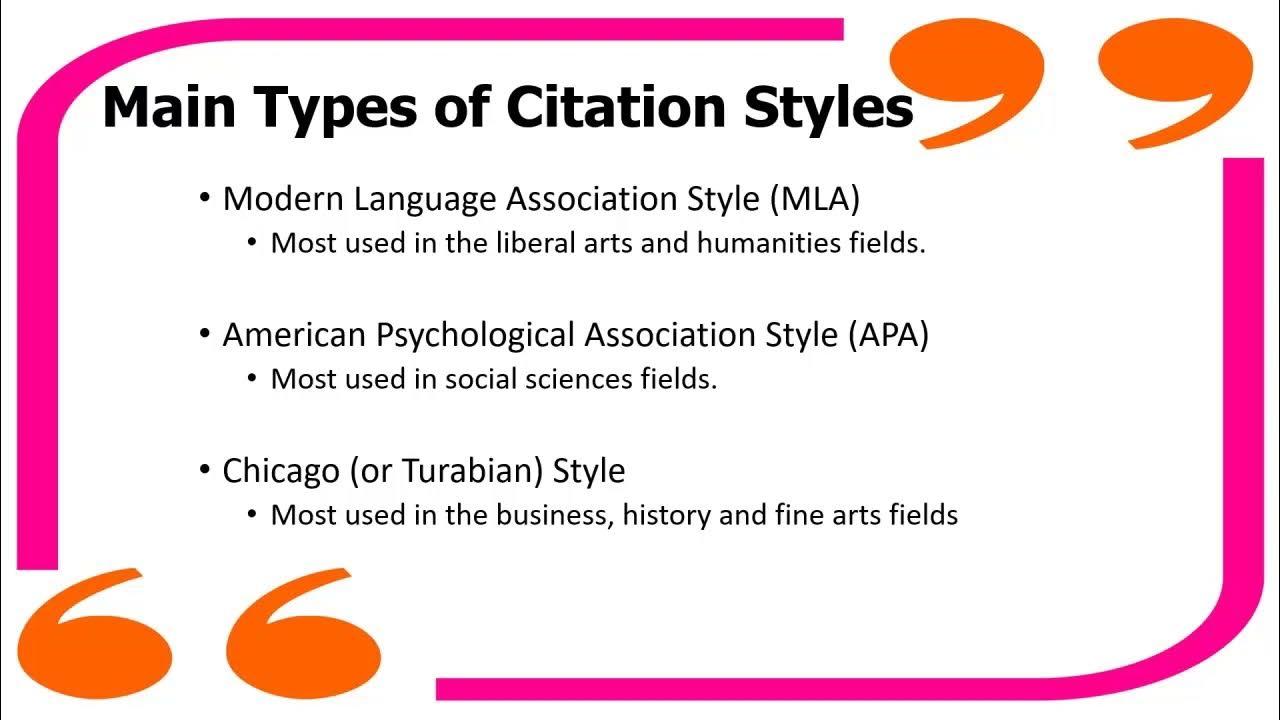The Basics of MLA In-text Citations | Scribbr 🎓
Summary
TLDRThis video explains how to properly cite sources using MLA in-text citations. Jessica from Scribbr covers key concepts such as when to use citations, how to format them (parenthetical or narrative), and how to handle various situations like multiple authors, missing information, or no page numbers. The video also touches on citing secondary sources and distinguishing between authors with the same last name. Viewers are encouraged to use Scribbr’s citation generator for convenience. The tutorial provides helpful tips to ensure correct MLA citation practices in academic writing.
Takeaways
- 😀 In-text citations are essential for identifying sources of information when you paraphrase or quote them.
- 😀 An in-text citation includes the author's last name and the page number (or page range) from the source.
- 😀 You can integrate in-text citations into a sentence in two ways: parenthetical or narrative citation.
- 😀 A parenthetical citation appears directly after the relevant quote or paraphrase and before the punctuation mark.
- 😀 A narrative citation places the author's name within the sentence, followed by the page number in parentheses.
- 😀 If citing multiple sources in a sentence, you can combine citations in one set of parentheses, separated by a semicolon.
- 😀 If a source has multiple authors, for two authors, name both; for more than two, use the first author's name followed by 'et al.'
- 😀 When the author is unknown, the in-text citation should match the first element of the Works Cited entry (e.g., the title or organization).
- 😀 For sources without page numbers, use chapter or section numbers if available. Otherwise, just use the author’s name in the citation.
- 😀 When citing works by the same author, add a shortened title to distinguish between sources. Titles of whole works are italicized, and titles of contained works are in quotation marks.
- 😀 To distinguish between authors with the same last name, include initials or full first names in the in-text citation.
- 😀 When citing a secondary source, use 'qtd. in' to indicate where the quote was found, but always try to cite the original source directly.
Q & A
What is the purpose of an MLA in-text citation?
-An MLA in-text citation is used to identify the source of information, helping readers locate the corresponding entry in the reference list at the end of a paper.
When should you include an in-text citation?
-You should include an in-text citation every time you paraphrase or quote from a source to give credit and support your claims.
What are the key elements of an MLA in-text citation?
-An MLA in-text citation consists of the author's last name and the page number (or page range) from the source.
What is the difference between a parenthetical citation and a narrative citation?
-A parenthetical citation places the citation in parentheses directly after the quote or paraphrase, while a narrative citation integrates the author’s name into the sentence, only adding the page number in parentheses.
How do you handle multiple sources in a single in-text citation?
-If you cite multiple sources, you can combine them in one set of parentheses, separating the sources with a semicolon.
How should you cite a source with two authors in MLA format?
-For a source with two authors, you should name both authors in the citation, separating their names with 'and'.
What if a source has more than two authors?
-If a source has more than two authors, you should name the first author followed by 'et al.', which means 'and others'.
How do you cite a source with no author?
-If a source has no author, the in-text citation should match the first element of the Works Cited entry, such as an organization name or a shortened version of the title.
How do you format titles in MLA citations based on the type of source?
-For self-contained works like books or websites, titles should be italicized. For sources contained within a larger whole, like a website page or book chapter, the title should be in quotation marks.
What should you do if the source does not have page numbers?
-If the source does not have page numbers, but is divided into numbered sections (e.g., chapters or scenes), use those numbers. If no numbering system exists, only the author's name is required in the citation.
Outlines

Cette section est réservée aux utilisateurs payants. Améliorez votre compte pour accéder à cette section.
Améliorer maintenantMindmap

Cette section est réservée aux utilisateurs payants. Améliorez votre compte pour accéder à cette section.
Améliorer maintenantKeywords

Cette section est réservée aux utilisateurs payants. Améliorez votre compte pour accéder à cette section.
Améliorer maintenantHighlights

Cette section est réservée aux utilisateurs payants. Améliorez votre compte pour accéder à cette section.
Améliorer maintenantTranscripts

Cette section est réservée aux utilisateurs payants. Améliorez votre compte pour accéder à cette section.
Améliorer maintenant5.0 / 5 (0 votes)






